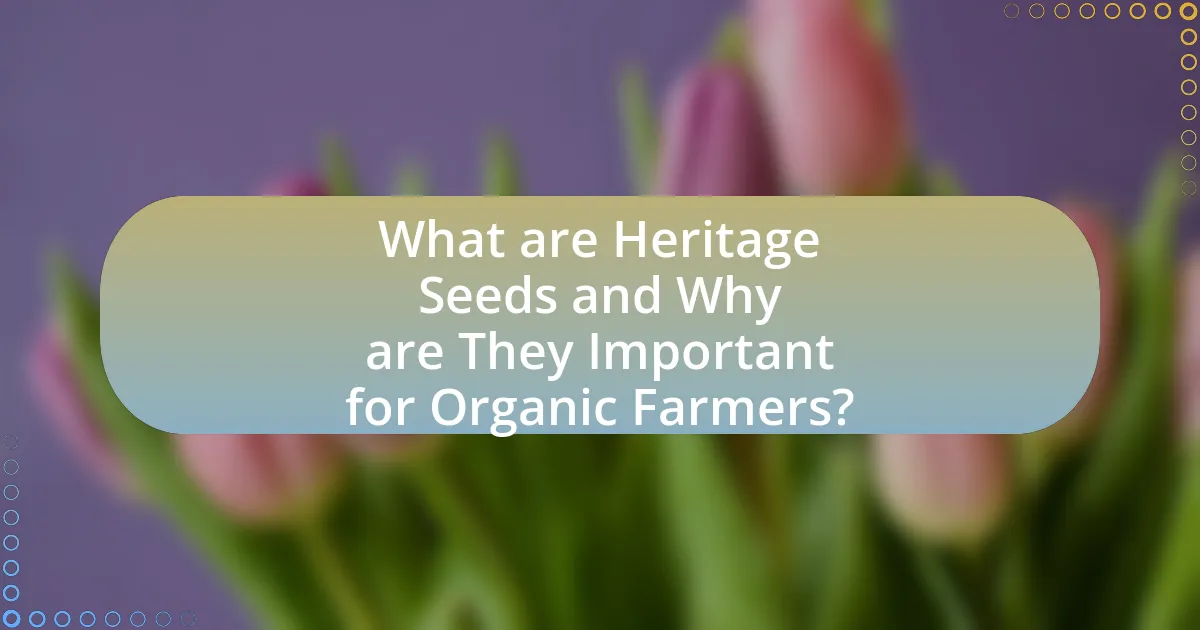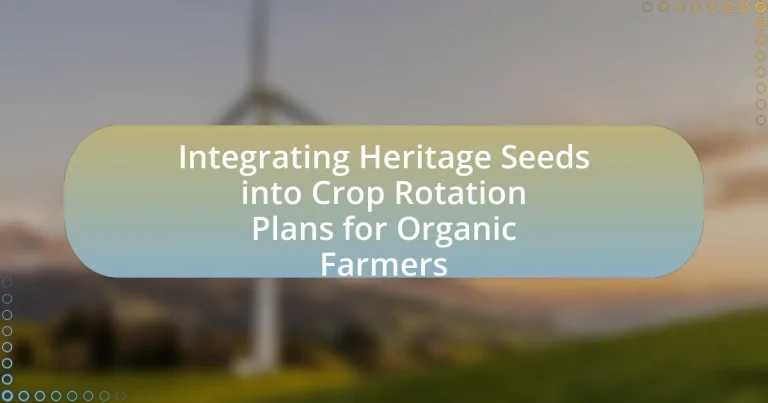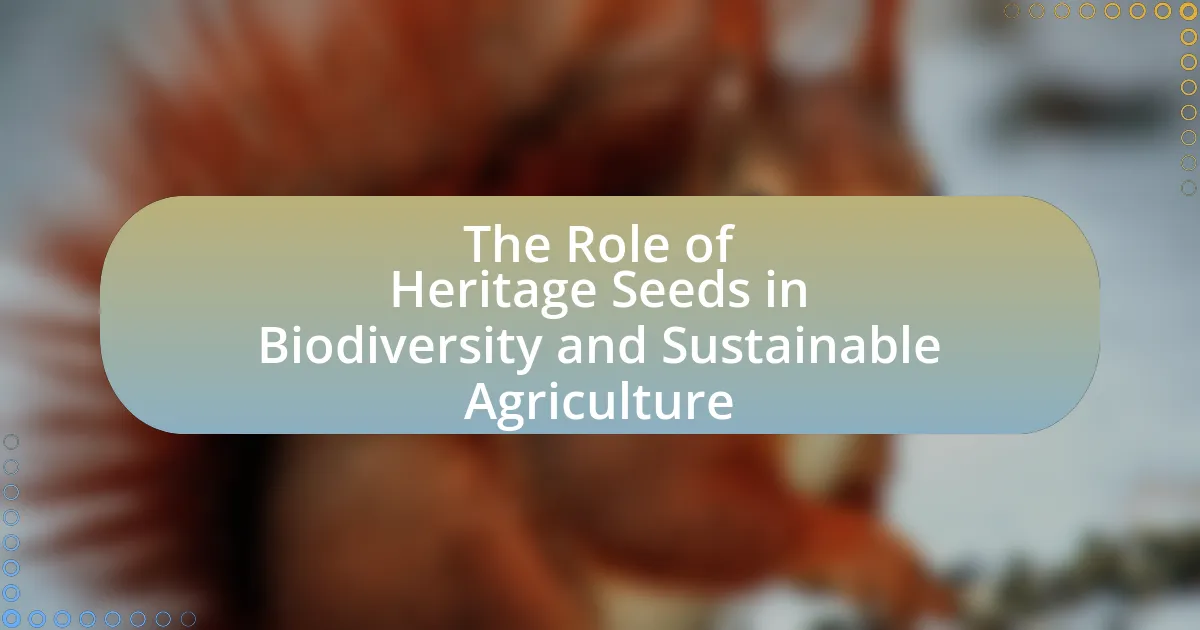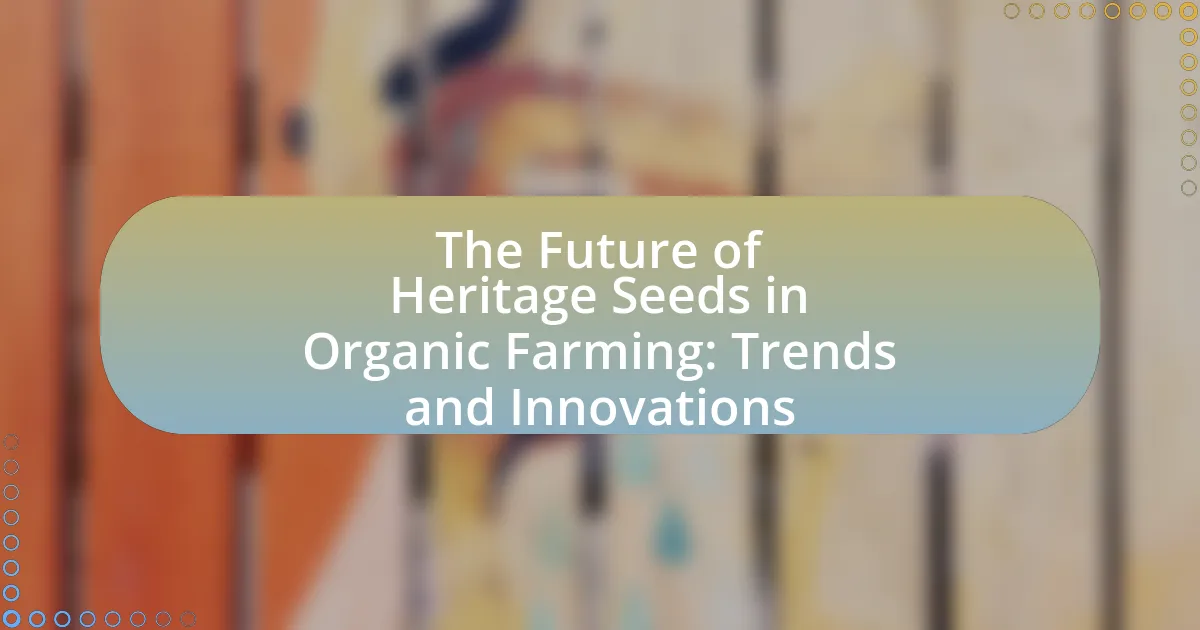Heritage seeds are traditional, open-pollinated varieties that have been cultivated over generations, offering unique flavors and adaptability to local conditions. This article explores the significance of integrating heritage seeds into crop rotation plans for organic farmers, highlighting their role in promoting biodiversity, enhancing soil health, and improving pest resistance. It discusses the differences between heritage, hybrid, and GMO seeds, the characteristics that define heritage seeds, and the sustainable practices associated with their use. Additionally, the article addresses the challenges organic farmers face when sourcing heritage seeds and provides strategies for successful integration into agricultural systems.

What are Heritage Seeds and Why are They Important for Organic Farmers?
Heritage seeds are traditional seed varieties that have been passed down through generations, often characterized by their adaptability, resilience, and unique flavors. These seeds are important for organic farmers because they promote biodiversity, enhance soil health, and provide crops that are better suited to local growing conditions. Studies have shown that heritage seeds can improve pest resistance and yield stability, making them a valuable asset in sustainable agriculture. Additionally, using heritage seeds helps preserve genetic diversity, which is crucial for food security and ecological balance.
How do Heritage Seeds differ from Hybrid and GMO Seeds?
Heritage seeds differ from hybrid and GMO seeds primarily in their genetic makeup and breeding processes. Heritage seeds are open-pollinated varieties that have been passed down through generations, maintaining genetic diversity and adaptability, while hybrid seeds result from controlled crossbreeding of two different parent plants to produce specific traits, and GMO seeds are genetically modified organisms that have been altered at the DNA level using biotechnology to express desired characteristics. Heritage seeds often exhibit resilience to local growing conditions and can be saved and replanted by farmers, unlike hybrid seeds which typically do not produce offspring with the same traits and GMO seeds which are often subject to patent restrictions.
What characteristics define Heritage Seeds?
Heritage seeds are defined by their open-pollinated nature, historical significance, and genetic diversity. These seeds have been passed down through generations, often cultivated by traditional farming methods, which ensures they retain their unique traits and adaptability to local environments. Heritage seeds typically exhibit resilience to pests and diseases, as well as the ability to thrive in various climatic conditions, making them valuable for sustainable agriculture. Their genetic diversity contributes to food security and biodiversity, as they can be used in crop rotation plans to enhance soil health and ecosystem balance.
Why are Heritage Seeds considered more sustainable?
Heritage seeds are considered more sustainable because they promote biodiversity and resilience in agricultural systems. These seeds are open-pollinated and have been cultivated over generations, allowing them to adapt to local conditions and resist pests and diseases more effectively than hybrid varieties. Research indicates that using heritage seeds can enhance soil health and reduce the need for chemical inputs, as they are often more suited to organic farming practices. Additionally, heritage seeds contribute to the preservation of genetic diversity, which is crucial for food security and ecosystem stability.
What role do Heritage Seeds play in biodiversity?
Heritage seeds play a crucial role in biodiversity by preserving genetic diversity within plant species. These seeds, often heirloom varieties, maintain traits that have adapted to local environments over generations, contributing to a wider gene pool. This genetic diversity is essential for ecosystem resilience, allowing crops to withstand pests, diseases, and changing climate conditions. Studies show that heritage seeds can enhance soil health and promote beneficial insect populations, further supporting agricultural biodiversity. By integrating heritage seeds into crop rotation plans, organic farmers can foster a more sustainable agricultural system that benefits both the environment and food security.
How do Heritage Seeds contribute to ecosystem health?
Heritage seeds contribute to ecosystem health by promoting biodiversity and enhancing soil fertility. These seeds are often well-adapted to local environments, which helps maintain genetic diversity within plant populations. Increased biodiversity supports a wider range of beneficial insects and microorganisms, which are crucial for pollination and nutrient cycling. Additionally, heritage seeds typically require fewer chemical inputs, reducing the risk of soil and water contamination. Research indicates that diverse cropping systems, including those utilizing heritage seeds, can improve soil structure and health, leading to more resilient ecosystems.
What are the implications of losing Heritage Seeds?
Losing heritage seeds has significant implications for biodiversity, food security, and agricultural sustainability. The extinction of these seeds reduces genetic diversity, which is crucial for crop resilience against pests, diseases, and climate change. For instance, heritage seeds often possess unique traits that can enhance adaptability, and their loss limits the options available to farmers, particularly organic farmers who rely on diverse crop rotations to maintain soil health and ecosystem balance. Furthermore, the decline in heritage seeds can lead to increased reliance on commercial seed varieties, which may not be as resilient or suited to local conditions, ultimately threatening food sovereignty and the cultural heritage associated with traditional farming practices.

How can Heritage Seeds be Integrated into Crop Rotation Plans?
Heritage seeds can be integrated into crop rotation plans by selecting varieties that enhance soil health and biodiversity. These seeds often possess traits such as drought resistance and pest tolerance, which can improve resilience in crop systems. For instance, rotating heritage varieties of legumes with grains can fix nitrogen in the soil, reducing the need for synthetic fertilizers. Research indicates that diverse crop rotations can lead to increased yields and reduced pest pressures, as seen in studies conducted by the Rodale Institute, which found that diverse rotations improved soil health and crop performance over time.
What are the benefits of incorporating Heritage Seeds into crop rotation?
Incorporating Heritage Seeds into crop rotation enhances biodiversity and improves soil health. Heritage Seeds, which are open-pollinated and adapted to local conditions, contribute to a more resilient ecosystem by promoting genetic diversity among crops. This diversity helps in pest and disease resistance, reducing the need for chemical inputs. Additionally, Heritage Seeds often have deeper root systems, which can improve soil structure and nutrient availability, leading to healthier crops. Research indicates that farms utilizing diverse crop rotations, including Heritage Seeds, can experience increased yields and reduced soil erosion, supporting sustainable agricultural practices.
How do Heritage Seeds enhance soil health?
Heritage seeds enhance soil health by promoting biodiversity and improving soil structure. These seeds, which are open-pollinated and adapted to local conditions, contribute to a diverse ecosystem that supports beneficial microorganisms and enhances nutrient cycling. Research indicates that diverse plant varieties can improve soil organic matter and reduce erosion, leading to healthier soils. For example, a study published in the journal “Agriculture, Ecosystems & Environment” found that crop diversity, including heritage varieties, significantly increased soil microbial diversity and activity, which are crucial for nutrient availability and soil fertility.
What impact do Heritage Seeds have on pest management?
Heritage seeds positively impact pest management by promoting biodiversity and enhancing ecosystem resilience. These seeds often originate from traditional varieties that have adapted to local conditions over time, leading to increased resistance to pests and diseases. Research indicates that diverse plantings, such as those using heritage seeds, can disrupt pest life cycles and reduce infestations by attracting beneficial insects that prey on pests. For example, a study published in the journal “Agriculture, Ecosystems & Environment” found that crop diversity significantly lowered pest populations in organic farming systems. This evidence supports the effectiveness of heritage seeds in sustainable pest management strategies.
What considerations should be made when planning crop rotations with Heritage Seeds?
When planning crop rotations with Heritage Seeds, farmers should consider the genetic diversity and adaptability of the seeds to local conditions. Heritage Seeds often possess traits that enhance resilience against pests and diseases, which can improve soil health and biodiversity. Additionally, understanding the specific nutrient requirements and growth patterns of each heritage variety is crucial for optimizing yield and minimizing competition among crops. Research indicates that diverse crop rotations can lead to improved soil structure and fertility, as well as reduced reliance on chemical inputs, aligning with organic farming principles.
How do climate and soil conditions affect the choice of Heritage Seeds?
Climate and soil conditions significantly influence the selection of Heritage Seeds, as these factors determine the adaptability and performance of specific seed varieties in a given environment. For instance, temperature, precipitation, and soil pH directly affect germination rates, growth patterns, and yield potential of Heritage Seeds. Research indicates that certain Heritage Seed varieties are bred to thrive in specific climatic zones; for example, varieties developed for cooler climates may not perform well in warmer regions. Additionally, soil fertility and texture play crucial roles; Heritage Seeds often require particular nutrient profiles and drainage conditions to flourish, which can vary widely across different agricultural landscapes. Therefore, understanding local climate and soil characteristics is essential for organic farmers to select the most suitable Heritage Seeds for their crop rotation plans, ensuring optimal growth and sustainability.
What are the best practices for selecting Heritage Seeds for rotation?
The best practices for selecting Heritage Seeds for rotation include choosing varieties that are well-adapted to local conditions, ensuring genetic diversity, and selecting seeds with proven resilience to pests and diseases. Local adaptation is crucial as it enhances the likelihood of successful growth and yield; for instance, seeds that have been cultivated in similar climates often perform better. Genetic diversity is important because it increases the resilience of crops to environmental changes and reduces the risk of total crop failure. Additionally, selecting heritage varieties known for their resistance to specific pests and diseases can minimize the need for chemical interventions, aligning with organic farming principles. Research indicates that using diverse heritage seeds can improve soil health and biodiversity, which are essential for sustainable farming practices.

What Challenges do Organic Farmers Face When Using Heritage Seeds?
Organic farmers face several challenges when using heritage seeds, primarily related to seed availability, disease resistance, and yield consistency. Heritage seeds are often less commercially available than hybrid seeds, making sourcing difficult. Additionally, these seeds may have lower resistance to pests and diseases compared to modern varieties, which can lead to increased crop loss. Furthermore, heritage seeds can exhibit variability in yield, making it challenging for farmers to predict production levels and plan effectively. Research indicates that while heritage seeds can contribute to biodiversity, their integration into crop rotation plans requires careful management to address these challenges effectively.
How can farmers overcome the challenges of sourcing Heritage Seeds?
Farmers can overcome the challenges of sourcing Heritage Seeds by establishing connections with local seed banks and participating in seed exchanges. These initiatives provide access to a diverse range of Heritage Seeds that are often not available through commercial channels. For instance, the Seed Savers Exchange, a well-known organization, facilitates the sharing of heirloom seeds among farmers, ensuring genetic diversity and resilience in crops. Additionally, farmers can collaborate with agricultural extension services and universities that focus on preserving Heritage Seeds, which can offer resources and guidance on sourcing and cultivating these varieties effectively.
What are the common barriers to accessing Heritage Seeds?
Common barriers to accessing Heritage Seeds include regulatory restrictions, limited availability from suppliers, and lack of awareness among farmers. Regulatory restrictions often arise from seed laws that favor commercial varieties, making it difficult for farmers to obtain Heritage Seeds legally. Limited availability occurs because many seed companies prioritize hybrid or genetically modified seeds, resulting in fewer options for Heritage varieties. Additionally, a lack of awareness among farmers about the benefits and sources of Heritage Seeds can hinder their adoption, as many may not know how to access these seeds or their advantages for biodiversity and sustainability in organic farming.
How can farmers build networks to share Heritage Seeds?
Farmers can build networks to share Heritage Seeds by forming local seed exchange groups and participating in community-supported agriculture initiatives. These networks facilitate the sharing of seeds among farmers, ensuring genetic diversity and the preservation of traditional varieties. Research indicates that community seed banks and cooperative farming practices enhance collaboration and resource sharing, which are essential for maintaining Heritage Seeds. For example, the Seed Savers Exchange, a well-known organization, has successfully connected thousands of farmers to share and preserve heirloom seeds, demonstrating the effectiveness of such networks in promoting sustainable agriculture.
What are the potential risks associated with using Heritage Seeds in crop rotation?
The potential risks associated with using Heritage Seeds in crop rotation include reduced disease resistance, lower yields, and potential incompatibility with modern agricultural practices. Heritage Seeds, while often valued for their genetic diversity and adaptability, may lack the disease resistance found in hybrid varieties, making crops more susceptible to pests and diseases. Additionally, these seeds may produce lower yields compared to high-yielding hybrids, which can impact overall farm productivity. Furthermore, the specific growing conditions and soil requirements of Heritage Seeds may not align with contemporary farming techniques, leading to challenges in crop management and reduced effectiveness in crop rotation strategies.
How can farmers mitigate the risks of crop failure with Heritage Seeds?
Farmers can mitigate the risks of crop failure with Heritage Seeds by incorporating diverse varieties into their crop rotation plans. This practice enhances genetic diversity, which increases resilience against pests, diseases, and changing climate conditions. Research indicates that diverse cropping systems can reduce the likelihood of total crop failure by up to 50%, as different seed varieties may respond differently to environmental stresses. Additionally, Heritage Seeds often possess traits that are well-suited to local conditions, further improving the chances of successful harvests.
What strategies can be employed to ensure successful integration of Heritage Seeds?
Successful integration of Heritage Seeds can be achieved through careful selection, proper soil management, and community engagement. Selecting Heritage Seeds that are well-suited to local climates and soil types ensures better adaptability and yield. Implementing soil management practices, such as crop rotation and organic amendments, enhances soil health, which is crucial for the growth of these seeds. Engaging with local farming communities fosters knowledge sharing and support, which can lead to improved practices and resilience in integrating Heritage Seeds into existing systems. These strategies are supported by studies indicating that diverse crop rotations and community collaboration significantly enhance agricultural sustainability and productivity.
What are the best practices for integrating Heritage Seeds into crop rotation plans?
The best practices for integrating Heritage Seeds into crop rotation plans include selecting diverse varieties, ensuring compatibility with local climate and soil conditions, and implementing a systematic rotation schedule. Diverse varieties enhance biodiversity, which can improve pest resistance and soil health. Compatibility with local conditions ensures that the seeds thrive and yield effectively. A systematic rotation schedule, typically involving a three to four-year cycle, helps prevent soil depletion and reduces disease pressure, as different crops can utilize nutrients differently and disrupt pest life cycles. Research indicates that crop rotation can increase yields by up to 20% compared to continuous cropping, demonstrating the effectiveness of these practices in sustainable agriculture.





